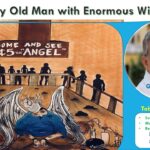This article contains the related questions and Answers to the Story “My Old Home” written by Lu Xun. For the simplicity of the reader, we also include the Download link PDF at the last of the article.
Read the full summary of ‘My Old Home’ written by Lu Xun to understand the exercise (Questions and Answers) of this chapter.

Understanding the text
Answer the following questions.
a. How does the narrator describe his feeling at the arrival of his old home?
The narrator becomes depressed at the arrival of his old home (hometown). In his childhood, his hometown was lovely and beautiful where the green sky lies above. But now, when Xun went back to his old hometown home after twenty years, he saw everything was changed. Green sky change into a vast and graying sky: they were drab, desolate, devoid of any semblance of life. There is no sign of progress. The condition of his home was extremely bad. The room was changed into old. It is not possible to change it by hand. His childhood memories deceive him here.
b. What were the three kinds of servants in China then? What does it indicate about contemporary Chinese society?
The three kinds of servants in China then were Yearlongs, short-timers, and busy-mothers. If they worked the whole year long for one family, they were “yearlong”; if they worked by the day, they were “short-timers”; and if they tilled their own land but worked for a specific family just during the holidays or when rents were collected, they were “busy-mothers.”)
c. What makes the narrator nostalgic? What did he do with Runtu in the teenage?
When the narrator’s mother asks him to meet his childhood friend Runtu, he becomes nostalgic. At the time of his teenage, He and Runtu went to catch the bird with a trick and also kill the Zha by stabbing it. They went to collect shells—reds, blues, ghost-scarers. They also went out to look for badgers and porcupines.
d. How did Runtu hunt a Zha in his young age?
Runtu hunted a Zha by roughly attacking with sharp or pointed objects (like knives) to Zha.
e. How does the narrator make a humorous picture of Mrs. Yang?
The narrator makes a humorous picture of Mrs. Yang by associating her with a woman who ran the beancurd shop. The narrator also makes Mrs. Yang picture in his mind; a lady who used to powder her face, and her cheekbones weren’t so high, nor were her
lips so thin.
f. According to the narrator, what were different factors that made Runtu a poor man throughout his life?
According to the narrator, a bad harvest is one of the main factors of his poorness. Besides it, other factors which made Runtu a poor man throughout his life are payment of high taxes, social responsibilities, too many children, famine, harsh taxes, soldiers, bandits, officials, and gentry folk.
g. How does the narrator help Runtu before leaving the old home?
The narrator helps Runtu by giving him different types of household items that make his life a bit easier; such as two long tables, an incense burner, some candlesticks, and a set of scales and also for the ashes from our kitchen stove.
h. How does the author differentiate two kinds of idols?
Two types of idols are discussed in the story by the author. They are superstitious and hopeful. “Superstitious idol” is worship for a short time for something immediate. But hope is not an idol that people desire to endure in the upcoming days.
Reference to the context
a. While reading the friendship between the narrator and Runtu, Hindu readers remember the friendship between Krishna and Sudama. Which particular description reminds you of the mythological example?
While reading about the friendship between the narrator and Runtu, Hindu readers remember the friendship between Krishna and Sudama. The story of Krishna and Sudama is taken from the Mahabharata epic. The situation of Xun’s Friend Runtu shown in this story (My Old Home) is similar to the situation of Krishna’s friend Sudama. Some of the particular descriptions of the story ‘My Old Home’ reminds us of this mythological example;
- This story shows that Runtu was a lower-class person than Xun. Similarly, Sudhama was a lower-class person than Lord Krishna.
- Xun’s friend Runtu is suffering from poverty like Krishna’s friend Sudhama.
- Runtu does not even fill his family’s stomach like Sudhama.
- Sudhama felt ashamed, and shy when he visited Krishna which was similar to the Runtu case. Runtu also felt ashamed, and shy when visited Xun thinking that Xun is rich and poor. His standard is like a servant in front of Xun.
- When Sudhama went to Krishna palace, he welcome him with his great heart. Similarly, When Runtu went to visit Xun, Xun welcome him with his great heart.
- At last, Krishna helped Sudhama by changing his hut to a palatial mansion where every facility was available to live a comfortable life. This case is not so much similar to Mahabharata epic to this story but it little similar to this story. Xun did not change Runtu’s house into a mansion but he gave him different household goods which make Runtu’s life a bit easier than previous ones.
From both stories, we learn that wealth not separated true friends. A true friend never makes feel to you that you are lower than him. They always respect you, not your wealth or your class. Wealth can’t buy a true friend.
b. How does the story support the proposition that the relationships of childhood are innocent, impartial, and disinterested?
The story supports the proposition that the relationships of childhood are innocent, impartial, and disinterested by giving the example of childhood friendship in the story. In childhood, children are innocent. They don’t know the meaning of lying, betraying, cleaver, and social boundaries. Children make friends in their childhood not for the seek of profit besides their friendship. They are natural. The relationship built-in childhood never is changed. They look at each other with the same eyes as in childhood and always help each other not only in childhood but also in the future. They can’t forget you until death. But in adulthood, everyone builds a relationship with other for seeking profit in many cases. Greed is concealed beside such a relationship. They forget you after their desire is fulfilled.
As shown in the story, Xun and Runtu were childhood friends. They used to play and enjoy themselves with each other. When Xun saw his friend Runtu with a problem, he helped him by providing him with different types of household items that make his life a bit easier; such as two long tables, an incense burner, some candlesticks, and a set of scales, and also for the ashes from our kitchen stove.
c. After reading the story, what inferences can you make about the contemporary Chinese economic and social system?
After reading the story, we come to the conclusion that;
1. This story shows the poor economic condition of people who were working in the agricultural field in ancient times in China. They didn’t even fill their family’s stomachs.
2. This story tells us about the different social boundaries which not allowed people to build a mutual relationship. In ancient China, the person is categorized into different classes; Yearlongs, short-timers, and busy mothers. If they worked the whole year long for one family, they were “yearlong”; if they worked by the day, they were “short-timers”; and if they tilled their own land but worked for a specific family just during the holidays or when rents were collected, they were “busy-mothers”). People of one class were not allowed to build any relations with other lower classes. This shows the narrow-mined of the ancient people of China.
d. What does the story indicate about the geographical features of the narrator’s hometown?
The story ‘My Old Home’ was set in 1921 in cold winter. In his childhood, his hometown was lovely and beautiful where the green sky lies above. But now, when Xun went back to his old hometown home after twenty years, he saw everything was changed. Green sky change into a vast and graying sky: they were drab, desolate, devoid of any semblance of life. There is no sign of progress. A blue-black sky, sandy terrain, and soft green melons as far as the eye could see were all described by the narrator during his visit to his farm.s visit to the farm. He also talked about how he caught the bird, kill the Zha, and how they (the narrator and his friend) go to the seaside to collect shells—reds, blues, ghost-scarers underneath the blue-black sky.
This story especially focuses on a hometown that was underneath the blue-black sky and the land covered with green grass and vegetables where the birds are flying.
For Downloading the PDF of this article, Click Below…
Are You Looking For…
| Neighbours Summary+Exercise | Download PDF |
| A Respectable Woman Summary+Exercise | Download PDF |
| A Devoted Son | Download PDF |
| A Devoted Son Exercise | Download PDF |
| The Treasure in the Forest Summary | Download PDF |
| The Treasure in the Forest Exercise | Download PDF |
| My Old Home Summary | Download PDF |
| My Old Home Exercises | Download PDF |
| The Half-closed Eyes of the Buddha and the Slowly Sinking Sun | Download PDF |
| The Half-Closed Eyes of the Buddha and the Slowly Sinking Sun Exercise | Download PDF |
| A very Old Man with Enormous Wings | Download PDF |
| A Very Old Man With Enormous Wings Exercise | Download PDF |





